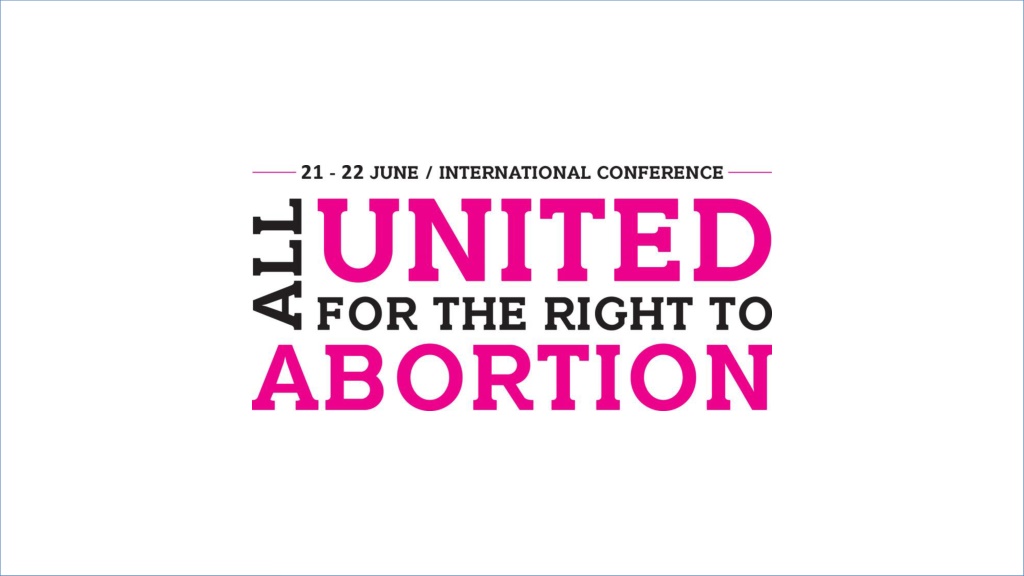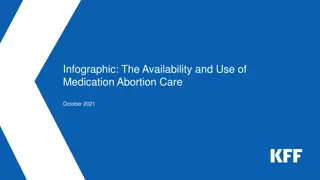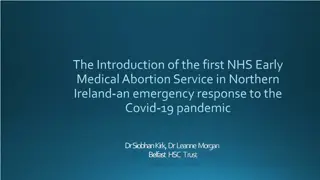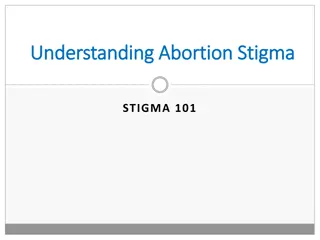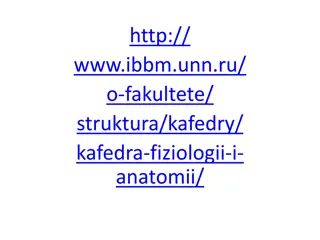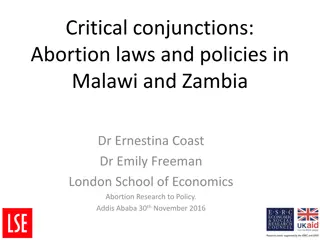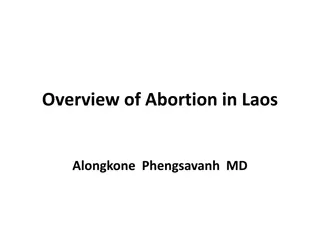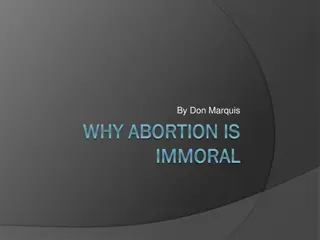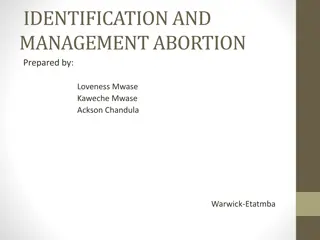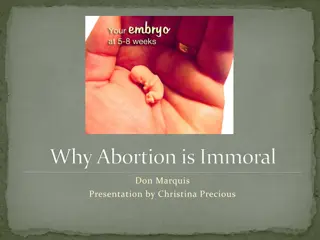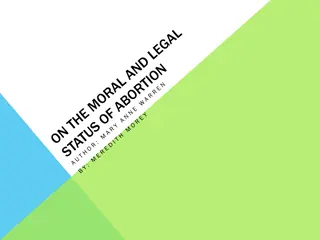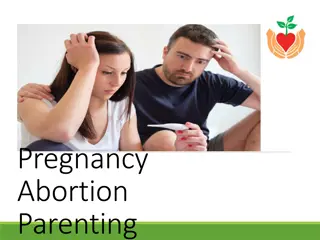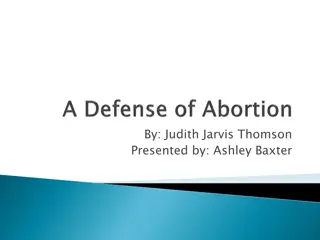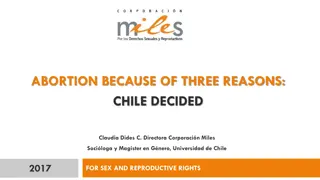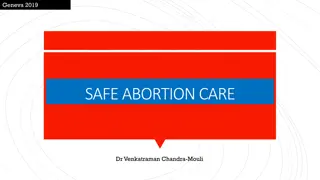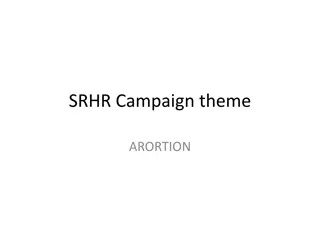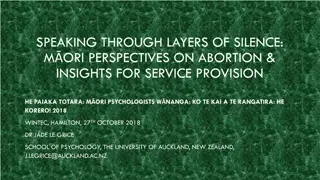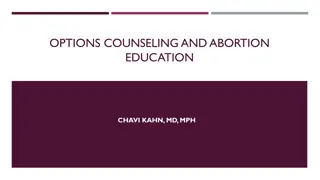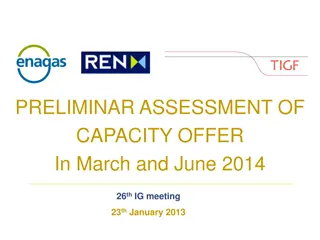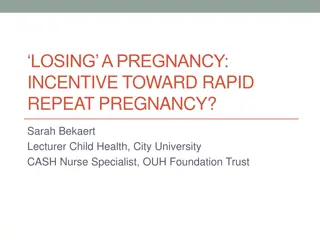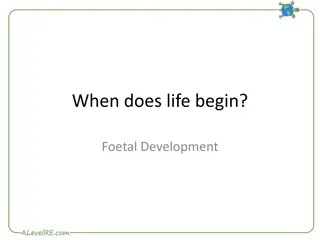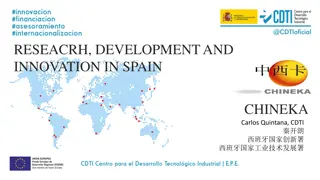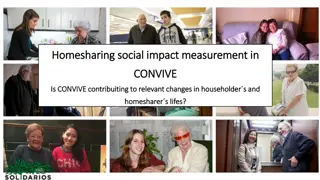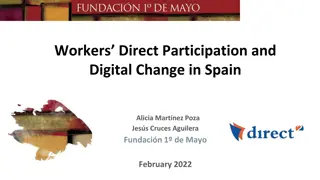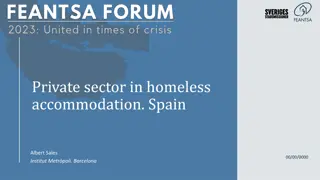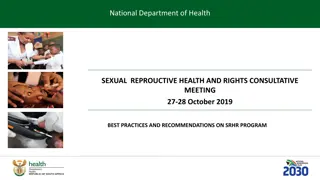Challenges and Progress in Access to Safe Abortion in Spain
Understanding the current landscape of safe abortion in Spain reveals obstacles like anti-choice harassment, geographic disparities, and conscientious objections. Despite legal protections, there are still challenges in ensuring access to abortion services, with issues like quality care and provider shortages hindering progress. Efforts to address these barriers include agreements with private clinics and training initiatives, but ongoing resistance and legal complaints pose threats to reproductive rights and healthcare. The situation underscores the importance of continued advocacy and support for normalized, equitable access to safe abortion services in Spain.
Download Presentation

Please find below an Image/Link to download the presentation.
The content on the website is provided AS IS for your information and personal use only. It may not be sold, licensed, or shared on other websites without obtaining consent from the author. Download presentation by click this link. If you encounter any issues during the download, it is possible that the publisher has removed the file from their server.
E N D
Presentation Transcript
Carolina Rivas Barrera Obstetrician & Gynecologist ACAI. Spanish Association of Clinics Authorized for termination of Pregnancy www.droitavortement.com
OBSTACLES AND RESISTANCE Barriers to achieve normalized, complete and equitable access to safe abortion within the Spanish Health System www.droitavortement.com
SRH and Abortion Law. 2010 On request, without restriction as to reason Up to 14 weeks Up to 22 weeks Fetal impairment Woman s life or physical/mental health at risk Up to 22 weeks Severe and incurable fetal disease (committee) or anomalies incompatible with life No time limit Training, conscientious objection and education www.droitavortement.com
SRH and Abortion Law. 2010 Service universally covered by the National Health System Staff no qualified nor motivated Agreements for outsourcing through specialized private clinics Since legalization more than 97% of total abortions have been performed in authorized clinics. Nowadays there are agreements between these clinics and the Regional Health Administrations in order to guarantee access to (free) abortion without any cost for women www.droitavortement.com
Current Barriers 1. Anti-choice harassment 2. Situation of women 16-17 y.o. 3. Geographycal inequity 4. Quality service and free choice of method 5. Concientious objection. Lack of providers www.droitavortement.com
1. Anti-Abortion harassment HARASSMENT RIGHT OUT THE CLINIS, to both women and professionals POLITICAL INSPECTIONS disguised as health inspections, from conservative regional governments related to these groups www.droitavortement.com
1. Anti-Abortion harassment LEGAL COMPLAINS AGAINST THE CLINICS FROM ANTI-CHOICE GROUPS, from different groups including the Association of Christian Lawyers Data protection, biological waste management and disposal, billing and tax offense, advertising and informative websites content Recently legal complaints against 20 clinics in 8 Regions for misinformation on their websites encouraging women to undergo abortion procedures by providing false information 6 clinics from Madrid were sanctioned. ACAI and ACL trial in October 18 www.droitavortement.com
1. Anti-Abortion harassment ELABORATION OF A LEGAL BILL THAT PROTECTS WOMEN S RIGHTS : Research on the regulations, legislations and legal judgments that have established jurisprudence in the european context, so it can be used by our politicians and authorities Among different european sentences that condemn harassment to women, rude aproach, use of pictures of fetuses and figures and direct advice from strangers the recent french law LOI no 2017-347 du 20 mars 2017 stands out. - Crime : preventing or trying to prevent the practice of abortion or obtaining information about an abortion, including electronic or online means. It includes dissemination or transmission of indications that may intentionally mislead, as a deterrent, about the characteristics or medical consequences of the termination of pregnancy - Sanction: up to 2 years in prison and 2.000 - 30.000 euro fine www.droitavortement.com
2. Women aged 16-17 All women under 18 y.o. are considered minors and therefore they are required to obtain parental consent Setback: 2015 amendment of the 2010 law (provide information to a legal guardian with exceptions) 12-13% of them alleged helplessness or conflict: family neglect, unstructured families, legal guardians in prison or abroad, risk of physical abuse, mother/father s incapacitating condition, guardians manifestly against abortion, or emancipated young foreign women living in the country with no legal tutors In two regions: the administration requires the consent of both parents AUTONOMY RESTRICTED frequently driven to an unsafe abortion or to an unwanted motherhood www.droitavortement.com
3. Geographical inequity 17 regions with different health regulations: ACCESS TO ABORTION IS NOT THE SAME EVERYWHERE About 82 specialized clinics (only 15 for pregnancies over 14 weeks) The unjustified requirements demanded by some regional health administrarions have forced the closure of second trimester centers. In some regions, public hospitals are the ones performing abortions after 14 weeks (malformations or physical health) In several regions, public health centers do carry out pharmacological abortions up to the 9th week of pregnancy. Hospitals perform those after 14 weeks (malformations or medical reasons) and outsourced clinics only perform surgical procedures up to the 14th week. www.droitavortement.com
3. Geographical inequity Inequity worsens in second trimester pregnancies REGIONAL REGULATIONS FOR SECOND TRIMESTER CLINICS Technical, sanitary, administrative, human resources and other requirements o Different regional regulation different requirements o Clinics had to shut down and it is difficult to create new ones o Women: o Travel to other Regional Communities Treated in Public Hospitals (frequently low quality services) www.droitavortement.com
3. Geographical inequity Inequity worsens in second trimester pregnancies DIFFERENCES IN INTERPRETATION OF THE LEGISLATION Strict interpretation of health at risk in the public health system (not taking into account the WHO definition of health) o Some hospitals/health professionals consider morally unacceptable as eligible for abortion some malformations (i.e. trisomy 21 or achondroplasia). Biased conscientious objection o Different clinical committees (for termination over 22 weeks) may differ in their judgment o www.droitavortement.com
4. Q.S. and free choice of method Integration of abortion services within the Public Health System Through only offering medical abortions At the expense of banishing instrumental techniques Not use of WHO definition of health Background -Induced abortion are not performed in public centers due to the lack of interest by both the Public Health System and most public health professionals, who do not receive any (oficial) training in this field. Abortions in Public Centers 2004 2,41 % 2011 2,6% 2013 8 % - Different regional administrations are supporting the integration in the PHS, eventually having them based on M.A. 2015 11 % 2016 11,7 % www.droitavortement.com * Data from Ministry of Health
4. Q.S. and free choice of method Integration of MEDICAL abortion within the Public Health System Main reasons It requires less training than instrumental abortion PHP had no training or way of acquiring practice in D&A or D&E (Abortion has not been part of the curriculum in any of the Health Sciences Schools or any areas of specialization) It requires less involvement by health professionals (the abortion is caused by the woman herself) Allied with conscientious objection Less professional stigma www.droitavortement.com
4. Q.S. and free choice of method Integration of MEDICAL abortion within the Public Health System Main reasons Lack of awareness about advantages and disadvantages of both techniques and about women s preferences It is assumed that it is cheaper than instrumental abortion Underestimation of the cost derived from complications, adverse effects, follow-up consultations and failure of the technique Pressure from the pharmaceutical industry www.droitavortement.com
4. Q.S. and free choice of method Instrumental vs. medical abortion Women s preferences in Spain Research carried out by ACAI in 2014 Almost 80% chose instrumental abortion (D&A) They alleged it is faster, less painful (specially under sedation, the preferred method), it requires less awareness and it has less interference in daily life Women who chose medical: they were scared of the instrumental procedure and they considered it less invasive Overall score (1-10): - - Instrumental: 9 Pharmacological: 7.4 www.droitavortement.com
4. Q.S. and free choice of method Instrumental vs. medical abortion Disadvantages of medical abortion Longer duration (mins-hours vs. hours-days) More painful More adverse effects (over 50%) Higher failure rate (2-7% vs 1%) When performed at home: should be accompanied Worsens in second trimester WHO: instrumental abortion is safer than medical induction when specialized ongoing training www.droitavortement.com
4. Q.S. and free choice of method Integration of MEDICAL abortion within the Public Health System Consequences Decrease of the quality of service (non specialized staff in non specialized centers) - Confidentiality and privacy not always well preserved (stigma) - Sometimes the staff is not motivated and do not want to be trained - No multidisciplinary teams: managing of pain, support and accompaniment (psycological, social) NOT OBSTETRICS www.droitavortement.com
4. Q.S. and free choice of method Integration of MEDICAL abortion within the Public Health System Consequences Confront WHO recommendation that states that all medical professionals performing abortions should be trained in all the existing techniques (not just to ensure women s free of choice, but also to be able to solve complications and failure of medical abortion) Prevents women from exercising free choice of abortion method, not just considering her medical situation but also her personal situation Growing deficient knowledge/experience of instrumental techniques - Perpetuate stigma, prevents normalization - Lack of generational replacement www.droitavortement.com
5. Conscientious objection and lack of generational replacement Deficient regulation of concientious objection Biased objection: type of malformation, mental health , method of the abortion Lack of generational replacement: not formal training, not normalization of the practice among other gyn&obs and medical practices, not ease the practice for willing providers Complete implementation of the SRH Law www.droitavortement.com
THANK YOU FOR YOU ATTENTION ACAI. Spanish Association of Clinics Authorized for termination of Pregnancy www.droitavortement.com
